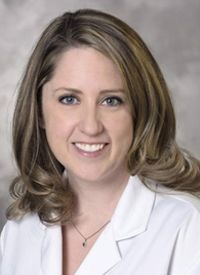Article
Case Series Shows Feasibility of Haploidentical Transplant in High-Risk Myelofibrosis
Author(s):
Haploidentical allogeneic stem cell transplant is a viable treatment option for patients with myelofibrosis who have a higher risk for posttransplant complications and mortality.
Keri Maher, DO, MS

Keri Maher, DO, MS
Haploidentical allogeneic stem cell transplant is a viable treatment option for patients with myelofibrosis who have a higher risk for posttransplant complications and mortality, according to a 3-patient case series shared in a poster at the 2020 Transplantation & Cellular Therapy Meetings.
The overall results of the retrospective analysis showed that at a median follow-up of 1.5 years (range, 456-656 days) posttransplant, all 3 patients were alive and not receiving immunosuppressants.
The median time to platelet engraftment was 67 days (range, 37-70) for patients 2 and 3. Infectious complications prevented patient 1’s time to platelet engraftment from being assessed. Across all 3 patients, the median time to neutrophil engraftment was day +22 (range, 20-24). At +30 days, the 3 patients had all achieved compete donor chimerisms with delayed recovery of marrow cellularity.
“Our case series using haploidentical donor source and busulfan/fludarabine/melphalan conditioning along with posttransplant cyclophosphamide for patients with MF demonstrates outcomes at least comparable to conventional donor source transplants,” wrote study authors Pei Zhang, MD, and Keri Maher, DO, MS, of the University of Arizona Cancer Center.
Here are the details for each patient in the case series.
Patient 1
Patient 1 was a 46-year-old female with primary MF who received the transplant 216 days after diagnosis. She had complex cytogenetics and her DIPPS+ Risk Category was 5 (high). The donor was the patient’s sister, and both were CMV+. The cell dose was 1.65 x 106. Pretransplant comorbidities were hypertension and hyperlipidemia.
The patient reached 100% donor chimerism at 30 days posttransplant. CMV reactivation occurred (esophagitis), as did BK virus in the urine and blood; however, there was not Epstein-Barr virus (EBV) reactivation. Infectious complications included invasive pulmonary aspergillosis, Burkholderia, and E. coli bacteremia. Additional complications included vesico-vaignal fistula and hypogammaglobulinemia, as well as chronic graft-versus-host (cGVH) disease in the upper gastrointestinal tract and mouth.
The patient was alive at day +656.
Patient 2
Patient 2 was a 57-year-old female with post—polycythemia vera MF who received the transplant 224 days after diagnosis. She had normal cytogenetics and her DIPPS+ Risk Category was 3 (intermediate-2). The donor was the patient’s daughter, and both were CMV+. The cell dose was 3.19 x 106. The patient had gout.
The patient reached 100% donor chimerism at 30 days posttransplant. CMV reactivation occurred, but BK virus and EBV reactivation did not. Patient had clostridium difficile colitis as an infectious complication. Additional complications included transfusional iron overload and moderate malnutrition. There were no GVH complications.
The patient was alive at day +532.
Patient 3
Patient 3 was a 61-year-old male with post—essential thrombocythemia MF who received the transplant 469 days after diagnosis. He had del 20q and his DIPPS+ Risk Category was 2 (intermediate-2). The donor was the patient’s sister, and both were CMV+. The cell dose was 2.07 x 106. Pretransplant comorbidities included hypertension, hyperlipidemia, coronary artery bypass graft, and myocardial infarction.
The patient reached 100% donor chimerism at 30 days posttransplant. CMV reactivation occurred, as did BK virus in the urine; however, there was not EBV reactivation. Infectious complications included Klebsiella bacteremia and influenza. Patient had cGVH in his eyes and mouth.
The patient was alive at day +456.
“Our findings are consistent with a growing body of literature supporting haploidentical transplant as a viable option in this patient population at high-risk for transplant-related mortality and poor transplant outcomes,” Zhang and Maher wrote in their concluding remarks.
Zhang P and Maher K. Haplo-Identical Allogeneic Stem Cell Transplant for Myelofibrosis: A Single-Center Case Series. Presented at: 2020 Transplantation & Cellular Therapy Meetings; February 19-23, 2020. Orlando, FL.









